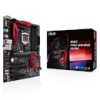Asus B150 PRO GAMING/AURA B150 PRO GAMING/AURA Users manual English - Page 75
Boot Option Priorities, Boot Override, DB Management
 |
View all Asus B150 PRO GAMING/AURA manuals
Add to My Manuals
Save this manual to your list of manuals |
Page 75 highlights
Delete key Allows you to delete the Key from your system. Configuration options: [Yes] [No] DB Management The db (Authorized Signature database) lists the signers or images of UEFI applications, operating system loaders, and UEFI drivers that you can load on the single computer. Set New Key Allows you to load the downloaded db from a USB storage device. Append Key Allows you to load the additional KEK from a storage device for an additional db and dbx loaded management. The KEK file must be formatted as a public key certificate or UEFI variable structure with time-based authenticated variable. Delete key Allows you to delete the Key from your system. Configuration options: [Yes] [No] DBX Management The DBX (Revoked Signature database) lists the forbidden images of db items that are no longer trusted and cannot be loaded. Set New Key Allows you to load the downloaded dbx from a USB storage device. Append Key Allows you to load the additional KEK from a storage device for an additional db and dbx loaded management. The KEK file must be formatted as a public key certificate or UEFI variable structure with time-based authenticated variable. Delete key Allows you to delete the Key from your system. Configuration options: [Yes] [No] 2.8.11 Boot Option Priorities These items specify the boot device priority sequence from the available devices. The number of device items that appears on the screen depends on the number of devices installed in the system. • To access Windows® OS in Safe Mode, press after POST (Windows® 8 not supported). • To select the boot device during system startup, press when ASUS Logo appears. 2.8.12 Boot Override These items displays the available devices. The number of device items that appears on the screen depends on the number of devices installed in the system. Click an item to start booting from the selected device. ASUS B150 PRO GAMING/AURA 2-39















